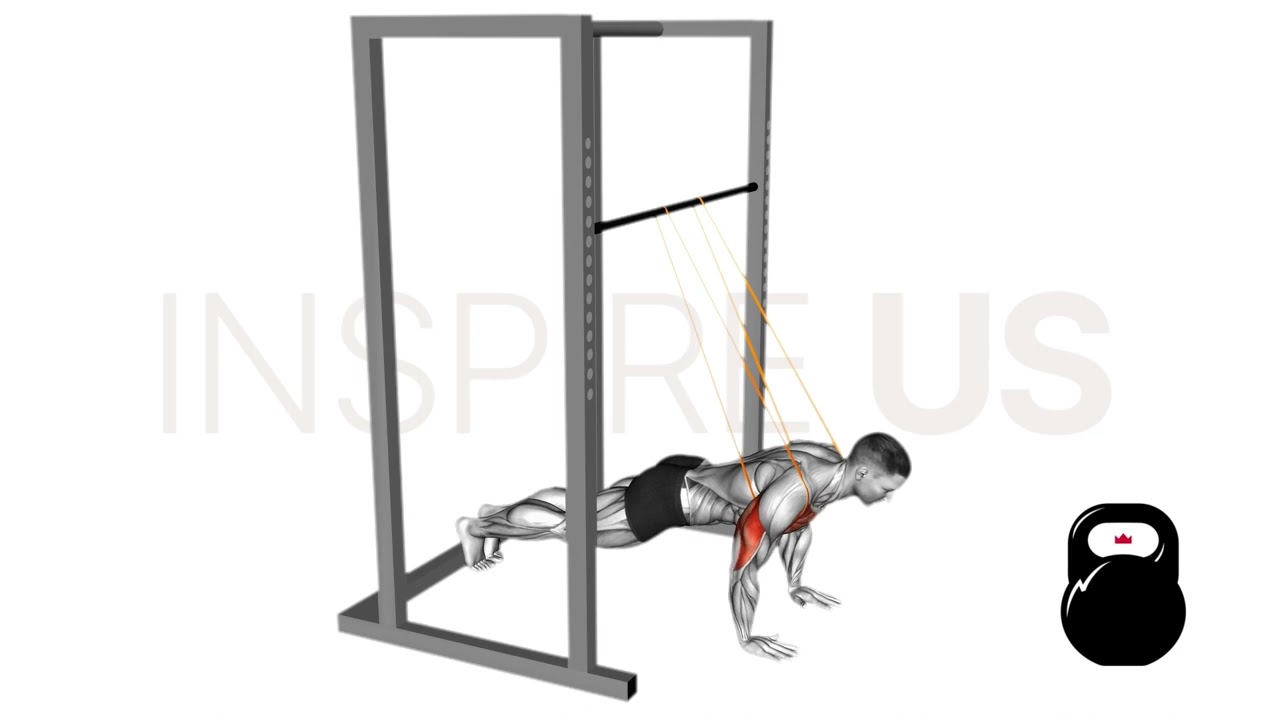Assisted Push-Up: Benefits, Muscles Worked, and More
Not all individuals start out able to perform a full push-up from the get-go. In fact, even with some training under their belt, performing a few repetitions of push-ups can still be physically exhausting.
It is for this reason that a number of “easier” push-up variations have been devised - one of which is known as the assisted push-up.
The assisted push-up is simply a conventional push-up with the applied level of resistance reduced through mechanical means, usually with a resistance band, TRX band, or cable machine.
A reduction in the amount of resistance placed on the muscles allows even beginner exercisers to perform push-ups with significant volume, providing them with a starting point for training progression.
What is an Assisted Push-Up?
Assisted push-ups are a multi-joint compound exercise performed as a substitute to conventional push-ups - usually for novice exercisers or individuals who are too heavy to perform regular push-ups to any effective amount of volume.
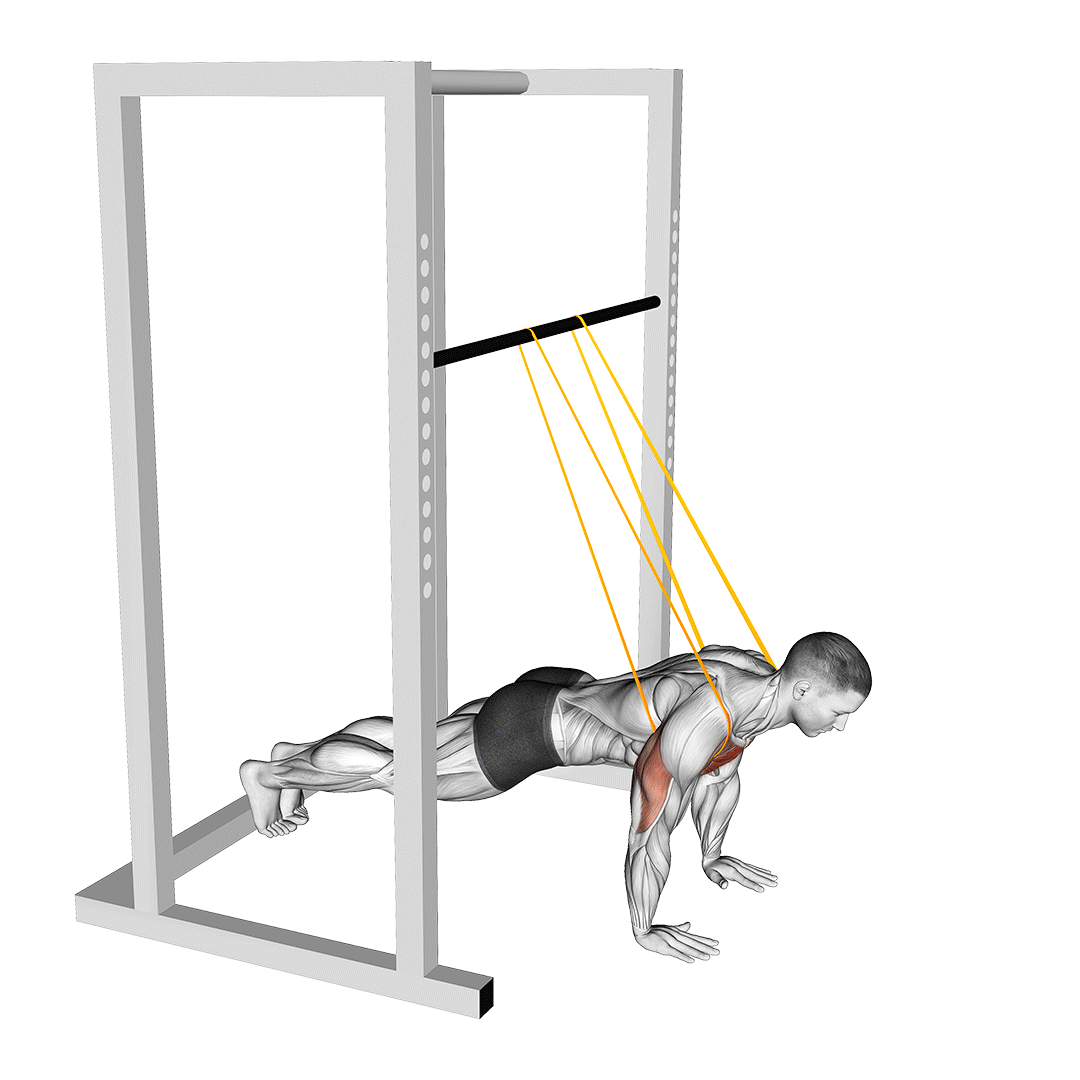
Mechanically and in terms of benefits, assisted push-ups are practically identical to their un-assisted counterpart, and will differ solely by the equipment needed to perform them and the intensity of each repetition.
Who Should Do Assisted Push-Ups?
Assisted push-ups are specifically meant for usage by individuals who cannot perform a conventional push-up - although they are occasionally used as an accessory movement to other compound pushing exercises as well.
Exercisers that are already capable of comfortably performing push-ups should not perform assisted push-ups, on the other hand, as doing so will limit how effective their training will be.
Muscular hypertrophy requires intensity of contraction alongside training volume, and as such reducing the amount of resistance involved can also reduce the hypertrophic response of the body to said training.
What Equipment is Needed for Assisted Push-Ups?
Assisted push-ups will require a resistance band to perform - but may also be done with a TRX band or cable machine belt squat attachment.
The goal of the equipment is to wrap around the torso or hips and provide counter-resistance to the body’s own weight, thereby reducing the load that is lifted by the muscles. As can be guessed from the variable equipment used, there is more than one way to go about achieving this.
How to do Assisted Push-Ups
To perform a repetition of assisted push-ups, the exerciser will wrap their chosen equipment around the torso or hips, ensuring that it is appropriately set-up to provide counter resistance to the body.
For resistance and TRX bands, this means wrapping the opposite end around a sufficiently distant object, whereas cable machines should have their pulley set to an appropriate angle and elevation.
Once the equipment is set up, the exerciser will enter the usual plank stance with their core contracted and hands set laterally parallel to the shoulders.
To begin the repetition, the exerciser will bend at the elbows and squeeze their chest muscles, slowly descending until their torso is within several inches of making contact with the floor.
Pausing for a moment, the exerciser will then reverse the motion by pushing through the palms of their hands, extending the elbows until they have returned to the starting plank position. At this point, the repetition is considered complete.
What Muscles are Worked by Assisted Push-Ups?
Assisted push-ups are a compound exercise, meaning that they work more than a single muscle as they are being performed - though not all to the same intensity.
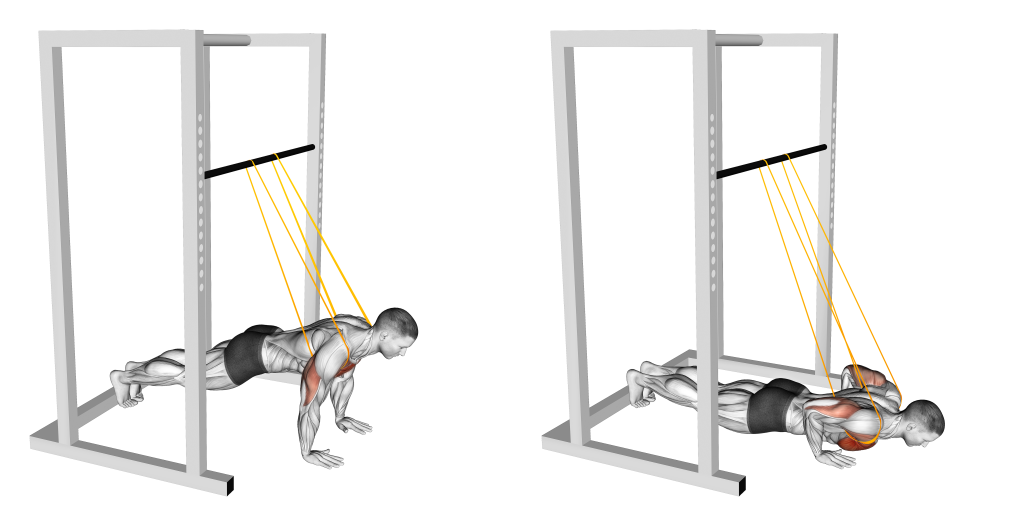
Muscles trained in a dynamic and more complete manner are called primary mover muscles, whereas muscles that are worked to a lesser extent (or solely in an isometric capacity) are called the secondary mover muscles and stabilizing muscles, respectively.
Primary Mover Muscles
The main muscles trained by assisted push-ups are; the pectoral or chest muscles, the anterior deltoid head and the triceps brachii. Each muscle is worked in an intense and dynamic fashion, and as such it is these three that receive the greatest benefit from assisted push-ups.
Secondary Mover Muscles and Stabilizing Muscles
Other muscles that are trained by the assisted push-up are the serratus anterior, abdominal muscles, glutes and forearms - of which are recruited in both secondary and stabilizing capacities.
What are the Benefits of Doing Assisted Push-Ups?
Apart from growing the muscles of the upper body, the assisted push-up is also used to achieve several other benefits that are not present in other exercise variations of the push-up.
Most of these benefits are of a protective or safety-related nature, and as such are particularly useful for exercisers just returning to training after time away.
Lower Impact, Less Wear on the Body
While conventional push-ups are already considered to be low-impact on their own, assisted push-ups take this aspect to another level by also reducing pressure on the wrists and shoulders - of which are the two greatest areas of strain for the regular variation.
Not only will this reduce the risk of developing overuse injuries in said areas, but it will also allow for a more forgiving exercise as a whole, even for novice exercisers that are making several mistakes in form.
Reduced Risk of Injury
Most exercises are considered to be safe if performed correctly, but the assisted push-up takes it to the next level by greatly reducing any sort of impart or pressure that the body may experience throughout each repetition.
As such, for novice exercisers who are particularly concerned about injuring themselves with other exercises, the assisted push-up may be the perfect choice. If they do not have access to the correct equipment, it is also possible to instead perform knee-ups and incline push-ups.
Comparatively Greater Capacity for Training Volume
Resistance is the most significant limiting factor to training volume, especially for individuals attempting to perform an exercise that may be too difficult for their level of conditioning.
Insufficient volume can affect how much a given muscle grows from a training session, with individuals performing too little total volume seeing a reduced amount of hypertrophy in comparison to another individual performing sufficient volume.
The assisted push-up helps with this by subtracting the amount of weight lifted by the muscles of the upper body, allowing those who have trouble completing a set of push-ups to perform a sufficient amount of volume with the assisted variation instead.
Excellent for Reinforcing Proper Push-Up Mechanics
Like all other resistance exercises, adhering to the correct form cues is one of the most important aspects of performing a push-up. Failing to do so can easily negate any benefits that may be derived from the exercise, if not injure the exerciser as well.
However, a paradox arises when a newbie exerciser finds themselves unfamiliar with the push-up, as it is not possible to truly learn correct push-up execution without practice - practice that first requires the exerciser to place themselves at risk of injury by performing the push-up with potentially poor form.
While the majority of novice exercisers avoid this by seeking out an athletic coach, at-home exercisers (as push-up performers often are) may not have access to such services.
Fortunately, performing the assisted push-up as an alternative is also perfectly suitable - allowing the exerciser to practice proper push-up mechanics without fear of injuring themselves. With a little research and repetition, mastering the push-up can safely be done on your own.
Most Common Mistakes of Assisted Push-Ups
As simple and safe as the assisted push-up is, there are several mistakes that are made by exercisers of all types - all of which, while unlikely to injure, should nonetheless be corrected so as to avoid building poor form habits.
Placing the Assistance Equipment Around the Legs
Throughout the assisted push-up, the legs should remain firmly on the ground and set in such a manner that the torso is stable as it moves through each repetition.
Placing the assistance equipment (i.e. the band or belt) around the legs can affect the stability of the exercise, as well as reduce how effective the equipment is at reducing the exerciser’s own bodyweight.
In order to ensure that the exercise is performed as intended, it is best to keep the equipment attached to the waist, pelvis, or shoulders rather than the legs.
Bouncing at Depth
Especially the case for resistance band assisted push-ups - bouncing from the bottom of the exercise by launching the torso off the ground can negate many of the muscular benefits derived therein.
In order to ensure that the muscles are trained to their fullest extent by the exercise, it is important to keep a lengthy time under tension with each repetition.
Once the descending phase of the repetition is complete, a pause should be taken before the ascending portion is performed - of which should also be done in a slow and controlled manner.
Poor Torso and Back Curvature
A common push-up mistake among novice exercisers is poor torso control, often as a result of failing to properly contract the core.
Performing the push-up with a sagging torso can reduce the range of motion of the movement, robbing the muscles of time under tension - just as how performing push-ups with the hips in the air can make the exercise more difficult.
Ideally, each repetition of the push-up (whether assisted or not) should be performed with the glute muscles firmly squeezed and the abdominal muscles contracted. Following these two form cues will ensure that the lower back remains at a flat and neutral curvature, and that the torso is rigid and parallel to the ground throughout the exercise.
Assisted Push-Up Progressions and Variations
The majority of exercisers performing the assisted push-up do so because they are unable to perform regular push-ups.
However, in cases where they cannot do so, there are other alternatives that may also play a similar role - all of which do not require the same equipment and offer much the same benefits.
1. Knee Push-Ups
For exercisers without access to the equipment necessary for assisted push-ups, an efficient substitute is to instead perform regular push-ups with the knees touching the ground.

This effectively reduces the amount of weight placed on the muscles of the upper body in the same way as an assisted push-up, allowing for more volume and a relatively lower risk of injury.
2. Incline Push-Ups
Alternatively, rather than elevating the knees, exercisers may make the conventional push-up easier by instead elevating the torso - of which will involve far less of the body’s weight being lifted by the muscles, and a significantly shorter range of motion.
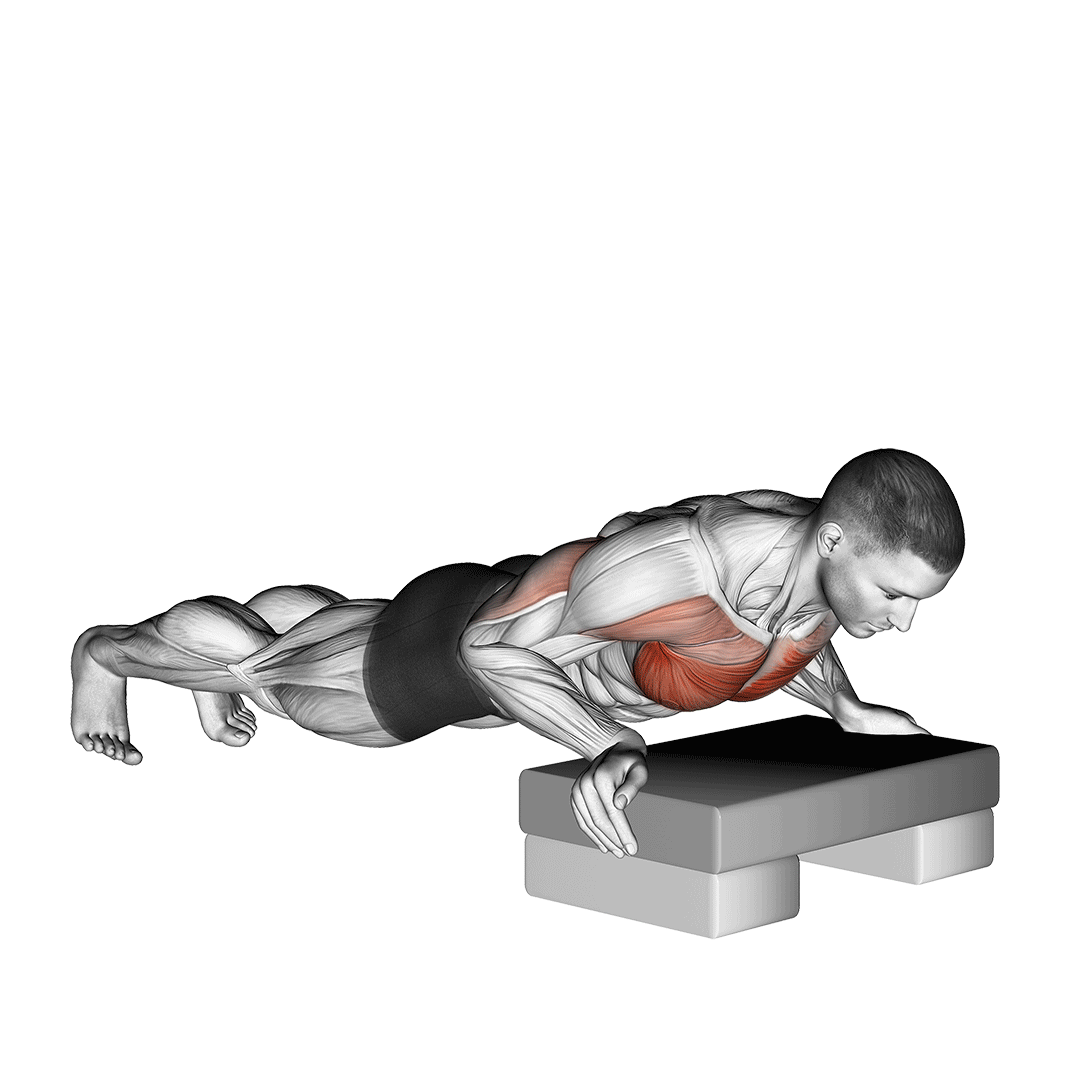
Incline push-ups also place a greater amount of emphasis on the lower portion of the pectoral muscles, making them an excellent accessory exercise for athletes lacking development in their lower chest.
3. Wall Push-Ups
Finally, rather than performing assisted push-ups, novice exercisers may instead perform wall push-ups.
Exactly as they sound, wall push-ups are simply push-ups performed in a standing position, with the exerciser pushing themselves away and to a wall so as to target the triceps, deltoids and chest.
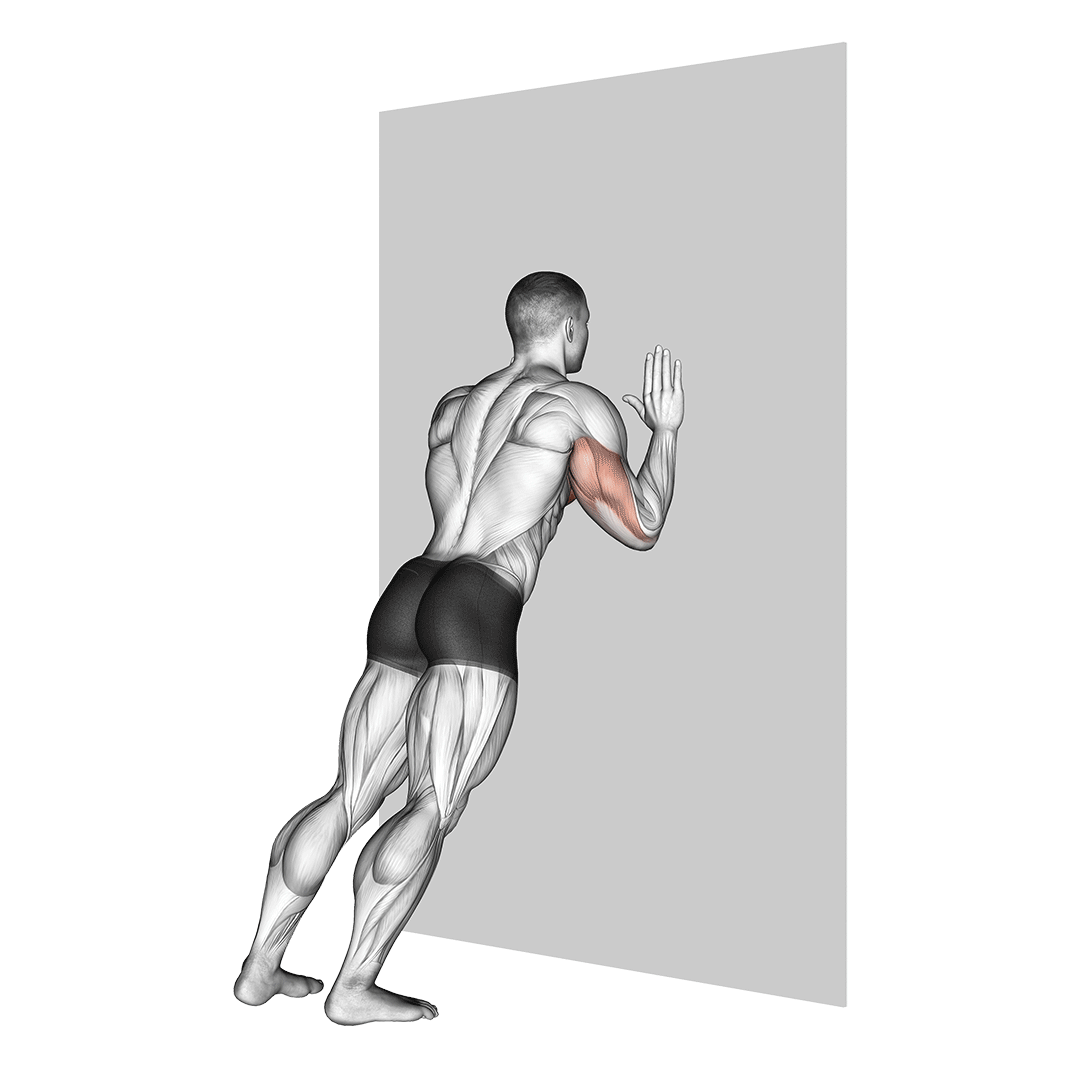
When Should You Switch From Assisted Push-Ups to Conventional Push-Ups?
Generally, assisted push-ups are used as a progression step to regular push-ups, as they do not provide the same intensity as the latter variation and as such will not be as effective as a training tool.
When exercisers wish to transition from the assisted variation to full push-ups, there are two trains of thought:
- The first is when they are sufficiently confident in their push-up mastery to safely perform push-ups
- The second answer is when the body is conditioned enough to handle conventional push-ups at volume.
When You’ve Mastered Push-Up Technique
Often, much of the reason why a novice exerciser cannot perform push-ups is due to poor form and unfamiliarity with the physical abilities of their own body. With regular practice of proper push-up technique, both issues are easily corrected.
Once the exerciser is confident that they can make full use of their upper body’s muscles and that they have a firm grasp of how to execute a push-up correctly, it is time to switch from assisted push-ups to conventional ones.
When You’re Strong Enough
Alternatively, preserving the flow of progressive overload by removing the counter-resistance of assisted push-ups is also one route to take.
While doing so won’t necessarily guarantee that the exerciser has mastered push-up technique, it will allow them to perform push-ups with sufficient volume, allowing the muscles to continue growing without being hampered by insufficient resistance.
Frequently Asked Questions (FAQ)
Do Assisted Push-Ups "Work"?
Yes - assisted push-ups work quite well when used in the right situation.
They are a progression to conventional push-ups, and are excellent for novices to resistance training or as an accessory to heavier movements.
Is a Knee Push-Up Better Than Full Push-Ups?
Knee push-ups are better than full push-ups if you can’t do a full push-up safely.
Otherwise, knee push-ups will be far less intense and involve less resistance than their conventional counterpart, meaning that the muscles of the body will be trained to a lesser degree.
Should I do Assisted Push-Ups Every Day?
No - doing any exercise every day will injure you.
Resistance training creates small tears in the fiber of your muscles, of which require time off from training to heal properly. Failing to allot sufficient recovery time for your body can lead to overtraining, injury and generally poor results.
In Conclusion
As effective as assisted push-ups are, remember that there are plenty of alternative exercises that can fill the same role. If you wish to eventually be strong enough to do conventional push-ups, movements like knee-ups, bench dips and wall push-ups can be just as useful as the assisted push-up.
So long as proper form and programming are followed, it is only a matter of time until the body grows strong enough to do regular push-ups. For the best results, combine novice-level training tools with sufficient recovery and an adequate diet.
References
1. Horsak B, Kiener M, Potzelsberger A, Siragy T. Serratus anterior and trapezius muscle activity during knee push-up plus and knee-plus exercises performed on a stable, an unstable surface and during sling-suspension. Phys Ther Sport. 2017;23:86-92. https://doi.org/10.1016/j.ptsp.2016.08.003.

